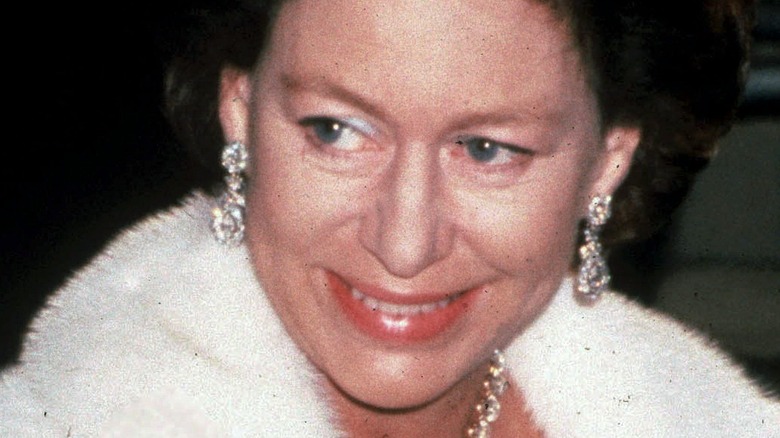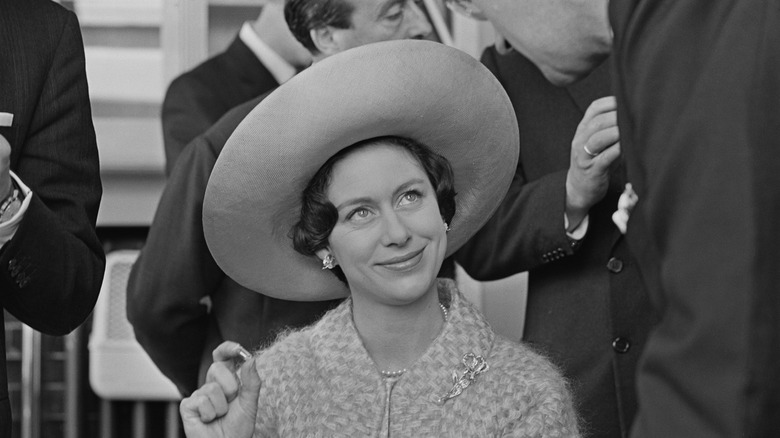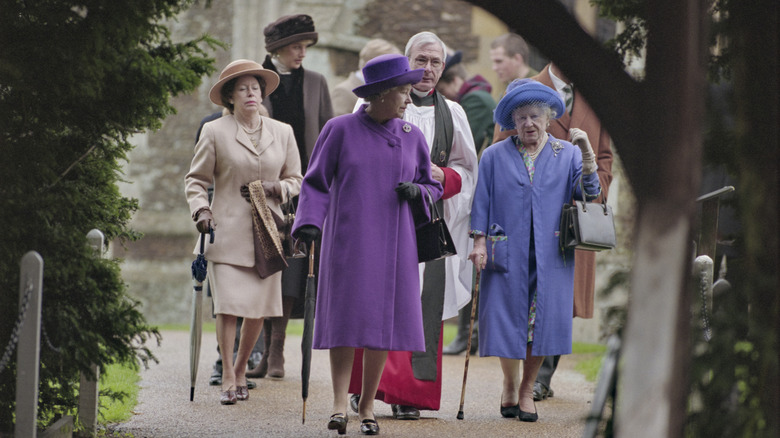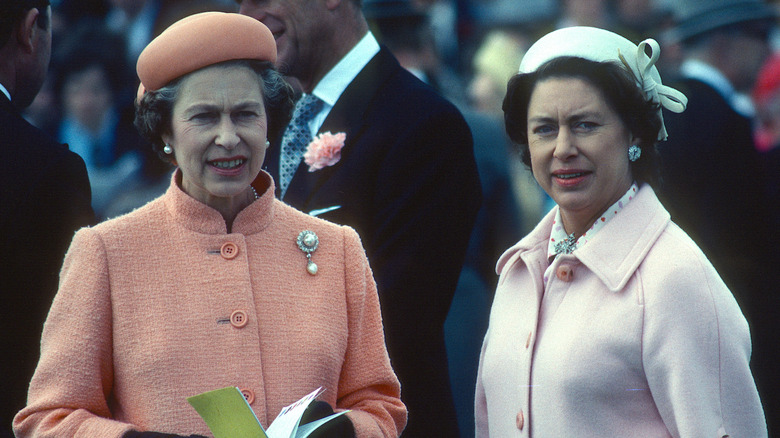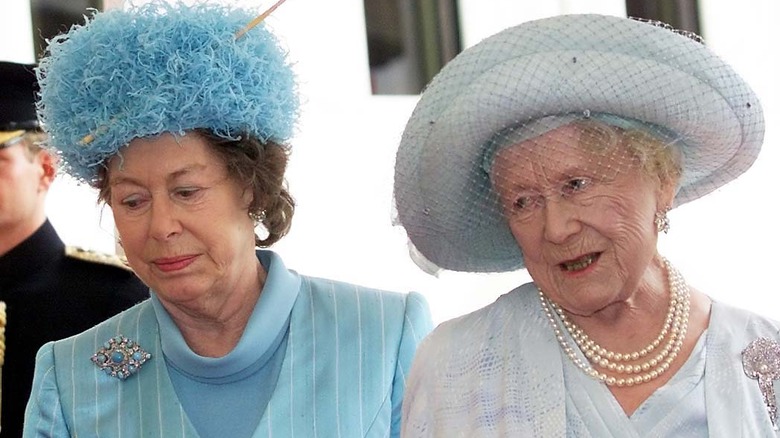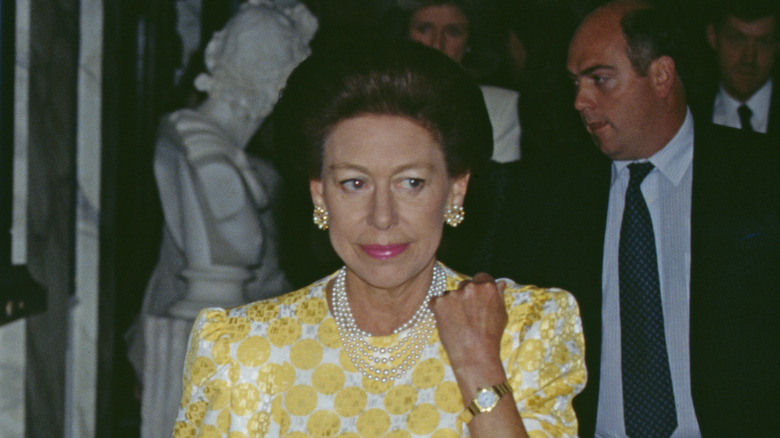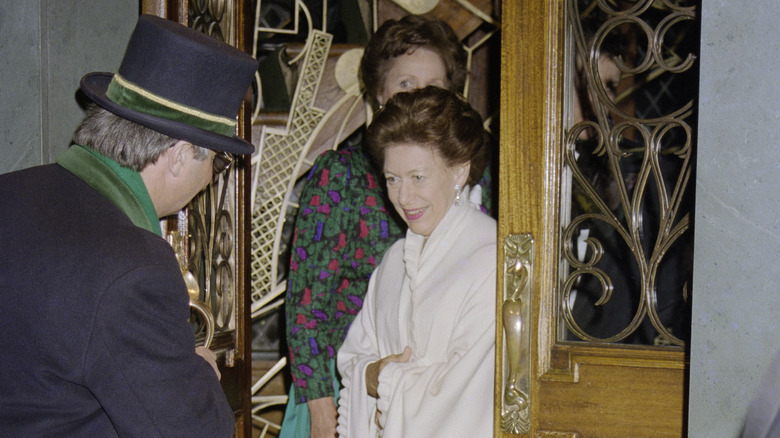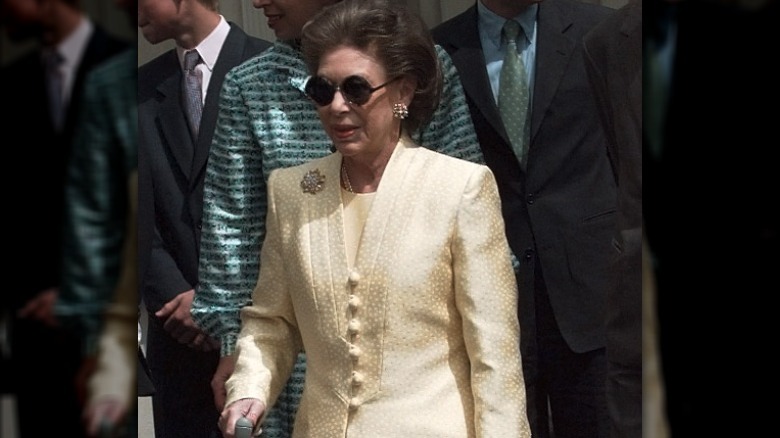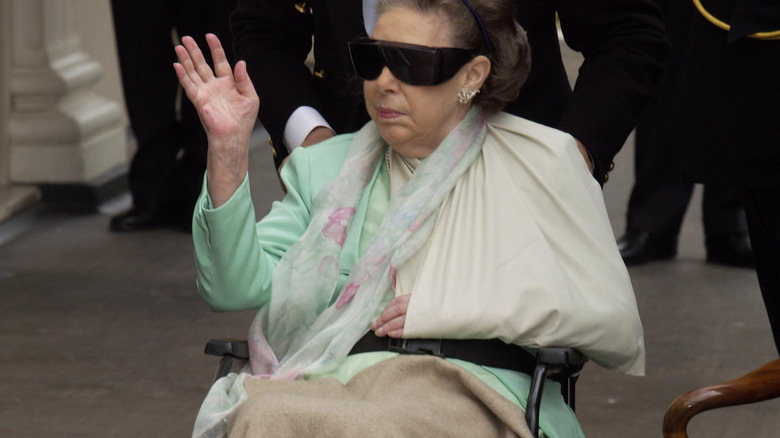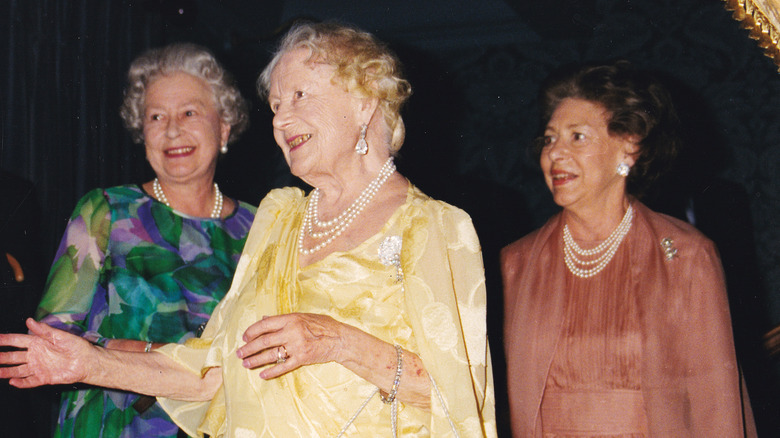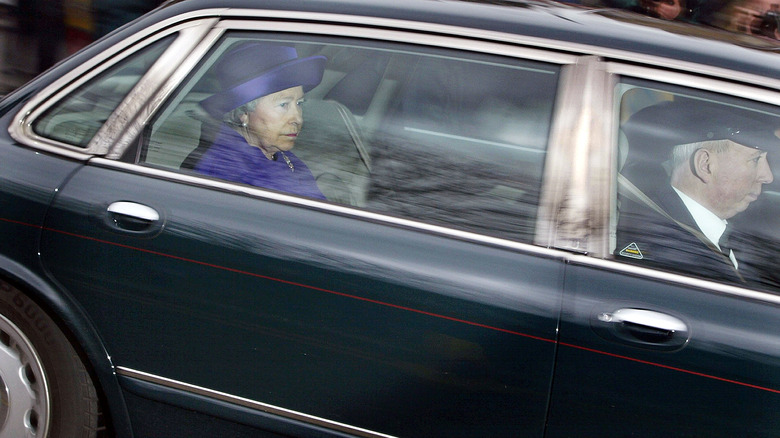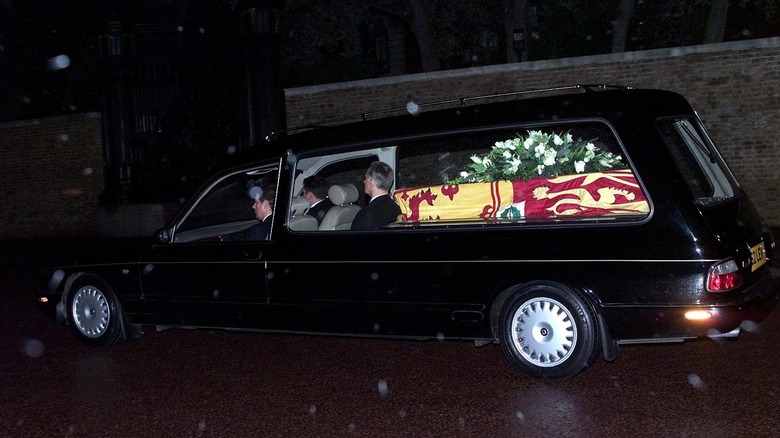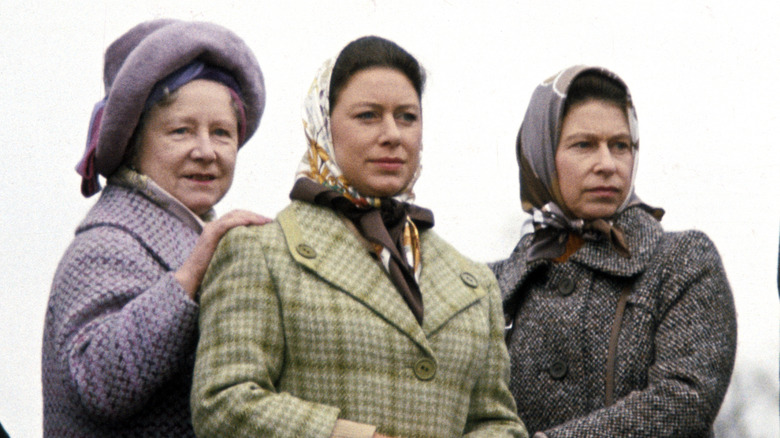What Princess Margaret's Final Years Were Really Like
Content warning: The following article contains language describing substance use, mental health challenges, and suicide.
With the ongoing scandal among the current batch of royals, it's easy to forget that there was a whole crowd of firm members at the center of drama well before Prince William and Prince Harry's infamous feud. One of the most trailblazing members of the royal family was Queen Elizabeth's younger sister Princess Margaret. The wild princess was known for living life in the fast lane, getting the first royal divorce in centuries, and consistently doing things her own way.
Any fan of "The Crown" can tell you that Season 1 focuses quite a lot on Margaret and her illicit affair with Group Captain Peter Townsend, a divorcee 16 years her senior. The two had a love for the ages, but due to his status as a once-married man and Margaret's young age, the princess had to get the queen's permission to marry him — no such luck. Margaret and Townsend eventually went their separate ways, but the heartbreak is just as palpable today.
Though she lived life largely on her own terms, Margaret's later years were mired by personal tragedy, health issues, and overall bad luck. She finally succumbed to ongoing health problems in 2002, dying horrifically close to her mother's death, delivering quite a blow to the royal family, particularly the queen, who lost a mother and a sister just weeks apart.
Margaret's personal life started to unravel in the late 1970s, impacting her health
Though her relationship with Group Captain Peter Townsend eventually unraveled, Princess Margaret got married to Antony Armstrong-Jones in 1960. For quite a while, the two were at the center of London's high society, and to be invited to one of their gatherings was an indication that you made it in the social scene. They rubbed shoulders with musicians, attended film premieres and concerts, and by all accounts were the most sought-after hosts throwing the most coveted parties in town. But, not dissimilar to royal marriages that came after her, Margaret's union to Armstrong-Jones began to come apart at the seams, and she was eventually caught having an affair in 1973 with Roderic Llewellyn, who was 18 years younger than her (via Biography).
Margaret's life did not emerge into a new sense of love and dedication with her newfound romance. In 1974, Margaret allegedly suffered a nervous breakdown due to her failed marriage, reportedly resulting in her family planting a bug in her room to keep tabs on her (via Biography). After seeking help for depression, multiple reports surfaced that the princess attempted suicide. "I was so exhausted because of everything that all I wanted to do was sleep," Margaret said. "And I did, right through to the following afternoon."
If you or anyone you know is having suicidal thoughts, please call the National Suicide Prevention Lifeline by dialing 988 or by calling 1-800-273-TALK (8255).
Margaret had a history of troubled health that plagued the end of her life
When Princess Margaret suffered her reported nervous breakdown in 1974, things sadly didn't improve. By 1976, the princess found herself at the center of a royal marriage gone wrong, and she and Antony Armstrong-Jones officially pulled the plug on their union (via Biography). Though she was photographed having an affair and her marriage was reportedly fraught with tension, divorce in the royal family was not nearly as common in her day — this was years before three out of four of Queen Elizabeth's children divorced their spouses. As such, Margaret's health reportedly took a significant turn, not only resulting in the aforementioned nervous breakdown but illnesses that landed her in the hands of medical professionals.
In 1978, Margaret was diagnosed with pneumonia while she was in the South Pacific (via the BBC). Her condition was drastic enough that she was airlifted to a hospital in neighboring Sydney, Australia. Just two years later, she was back in the hospital to have a benign skin lesion removed. By 1985, she was in the operating room for an eerily reminiscent procedure that marked the downfall of her own father's life decades prior.
Margaret had a sordid past with smoking
Queen Elizabeth and Princess Margaret were born to Queen Elizabeth The Queen Mother and King George VI, who famously took the throne after his brother abdicated in 1936. By 1951, the king's health had declined in part due to his smoking. That same year he underwent a lung operation that not only determined he had lung cancer but had spread to his left and right lungs. By February 1952, the king died at the age of 56. This did not deter his daughter Margaret from picking up the habit herself, however. The princess was known for smoking Chesterfield cigarettes and often paired them with a whisky or gin beverage (via WalesOnline). Due in part to her unhealthy habits, Margaret developed laryngitis, pneumonia, and bronchitis throughout her life, but it was her 1985 operation that truly had people drawing stark comparisons.
Similar to her father, Margaret had a cancer scare and underwent an operation to remove tissue from her left lung. Though test results came back and the tissue was benign, Margaret did not give up but continued smoking. Her habit even skyrocketed the year prior when she quit drinking for a period of time. At the height of this, Margaret was said to smoke about 60 cigarettes a day — after her operation, she cut back to 30 cigarettes (via The Guardian).
The princess suffered her first stroke in 1998
Such a history of health issues plagued with heavy smoking and drinking caught up with Princess Margaret by the 1990s. In the first half of the decade, she was once again hospitalized with pneumonia and transported to King Edward VII Hospital after residing with friends just outside of the city of London (via the BBC). Throughout the decade, Margaret started residing at her property in the Caribbean far more than in England, maintaining her partying ways and causing a bit of an uproar among the British public while doing so. But in 1998, things came to a halt when the princess survived her first stroke.
After three weeks at her Caribbean property on the island of Mustique, Margaret was enjoying a meal with friends when she first started feeling off (via The New York Times). The princess made it known that her head was starting to hurt. Her headaches were followed by dizziness, and then by pains in her chest (via The Guardian). She was transported to a hospital in nearby Barbados to get the all-clear to fly back to England. Margaret experienced a mild stroke and gave up smoking for a time. She appeared in rather good spirits when she was spotted leaving the hospital, walking to the car on her own but refusing to comment to clamoring reporters.
1999 brought yet another troubling health scare to the princess
Rumblings about Princess Margaret's health continued to surface in the late 1990s following her first stroke. Though her health scare in the Caribbean was deemed mild at the time, Margaret's lifestyle had certainly appeared to catch up with her. In 1999, a London newspaper claimed that she was incredibly sick and required around-the-clock care. Soon after the report hit the stands, the BBC's royal correspondent Nicholas Witchell negated the claim. But it was only a matter of time before Margaret was back in the headlines — this time for a very real health-related accident that left her in a rather bad way.
Margaret was back at her holiday home in Mustique just a year following her stroke when she seriously scalded her feet getting into a hot bath. The news was confirmed by a palace spokesperson who told the press: "She was seen by a local doctor in Mustique, and came back to London a week after the accident. She is now recuperating at Windsor, but these things do take some time to heal" (via the BBC). Adding that the princess was staying positive amid the accident, the palace spokesperson further noted that Margaret was being aided by a nurse during her recovery. The accident left Margaret unable to walk for a period of time, and questions about the incident and what truly happened have remained unanswered.
Margaret had a second stroke in January 2001
Princess Margaret suffered her first stroke in 1998, scalded her feet in 1999, and by January 2001, she suffered yet another stroke. At the time, Margaret was transported once again to King Edward VII Hospital after she stopped eating (via the BBC). Her lack of appetite was connected to a possible second stroke, and she remained at the hospital for observation. Speaking to the BBC after visiting his aunt, then-Prince Charles told reporters that despite the health scare, Margaret was making daily improvements and had even started eating meals here and there. It was rather a sight to behold, as Charles had his arm in a sling after fracturing his shoulder — the royals certainly looked like they were worse for wear.
"She is coming on very well — she's much better," Charles said (via the BBC). The BBC further noted at the time that Charles was the highest-ranking member of the royal family to travel to the hospital to see Margaret. Her daughter Lady Sarah Chatto was also seen visiting the princess, bringing along her children Samuel and Arthur who were children at the time. Unlike Charles, Sarah did not comment on her mother's condition or improvement. The only other rumbling came from doctors, who stated through the palace that Margaret was not considered a critical case.
Margaret had a third stroke in March 2001
The year 2001 started off poorly for Princess Margaret. Losing her appetite over the Christmas holiday, she was hospitalized for a second stroke — as aforementioned — in January 2001. But just two months later, the princess was back in the hospital after suffering a third stroke which certainly left her in a worse condition. In March 2001, Margaret developed similar symptoms as her previous stroke when she was hospitalized, traveling once again to King Edward VII Hospital to receive around-the-clock care (via The Guardian). After receiving the all-clear from doctors, Margaret was allowed to travel back to her home in Kensington Palace. A statement from palace officials released at the time read: "It will be some while before the extent of her recovery can be determined. She is happy to stay among her own things where she is comfortable and among her family."
In the aftermath of the stroke, the health incident was officially noted as a minor attack, but the impacts of the third stroke certainly showed themselves with time. Margaret's function on her left side was impacted by her third stroke as well as her vision, and she required consistent nursing care at home (via The Guardian). It was also alleged that the princess became incredibly distant after her third stroke, rarely leaving her bed and denying both food and the company of others.
Margaret suffered a fourth stroke just a year later, landing her in the hospital
In the last years of her life, Princess Margaret did not radiate the same kind of energy that she was so often known for — the life of the party and the most brilliant host of high society. Instead, she was rarely spotted in public, relied on the use of a wheelchair, and clearly suffered at the hands of her vices — smoking, heavy drinking, and of course multiple strokes with varying degrees of severity. But in early 2002 — about 11 months after the stroke that resulted in ongoing care and a possibly reclusive lifestyle — the princess suffered yet another stroke, this time with very little room for the royals to cover up its seriousness.
"Princess Margaret suffered a further stroke yesterday afternoon. She developed cardiac problems during the night and was taken from Kensington Palace to The King Edward VII Hospital at 2.30am," Buckingham Palace detailed in a statement at the time (via Hello!). "Lord Linley and Lady Sarah were with her, and the queen was kept fully informed throughout the night."
The news, though tragic, did not come as a huge surprise to the British public. Many newspapers had jumped on the Margaret health bandwagon, reporting that her isolation from public royal life was due to her ongoing health issues, both physical and mental (via Oprah Daily).
The princess succumbed to her health problems and died in 2002
It was with immense sorrow that Queen Elizabeth announced to the British press and public that her younger sister Princess Margaret died due to complications of a stroke on February 9, 2002 — the aforementioned incident that landed her once again in the hospital.
"The Queen, with great sadness, has asked for the following announcement to be made immediately," read a statement by Buckingham Palace (via Hello!) "Her beloved sister, Princess Margaret, died peacefully in her sleep this morning at 6.30am, in The King Edward VII Hospital. Her children, Lord Linley and Lady Sarah Chatto, were at her side."
At just 71 years old, Margaret's life had caught up to her — from cancer scares and mental health issues to the stroke that left her partially paralyzed on the left side, the princess suffered immensely toward the end of her life. In the immediate aftermath of her death, Margaret was mourned by those near and far, with then-Prime Minister Tony Blair — who was in West Africa at the time — releasing a statement mourning the loss (via The New York Times). Tragically, Margaret's mother Queen Elizabeth The Queen Mother would die just weeks after on March 30, 2002, with her reigning daughter at her side. To say that 2002 ushered in a horrific few weeks for the royal family is a serious understatement.
Tributes quickly poured in, and Margaret's bad health habits were notably kept out of statements
Though Princess Margaret's vices — notably cigarettes and alcohol — were the worst-kept secrets in Britain, her detrimental health habits were largely kept out of statements mourning her death. The country of Scotland significantly mourned Margaret's passing, with the Scottish secretary Helen Liddell stating: "I deeply regret the death of Princess Margaret and send my condolences to Her Majesty the Queen Mother and Princess Margaret's two children" (via the BBC). Her words were echoed by first minister Jack McConnell, who said: "All of Scotland will be saddened by the death of her Royal Highness Princess Margaret. She served her country well over many years. Our sympathy and thoughts are with the Queen and Princess Margaret's family at this sad time. "
Oddly enough, one of the only tributes that actually acknowledged Margaret's declining health and nodded to the cigarettes and alcohol that contributed to her decline was offered by then-Prince Charles, indicating that his aunt's passing was a long time coming. Though he didn't explicitly mention her substance use, Charles did dance around the issue. "My darling aunt had such a dreadful time in the last few years with this illness, it was hard for [her] let alone her to bear it but all of us as well, particularly as she had such a wonderfully free spirit," he said at the time (via the BBC).
Margaret's funeral was held on the 50th anniversary of her father's own funeral
Princess Margaret was eerily connected to her late father King George VI in more ways than one. She underwent an incredibly similar procedure when faced with a cancer scare — a blast from the past that ultimately marked the late king's demise. In death, the two were linked in a jaw-dropping way — her funeral was held on the 50th anniversary of her father's own state funeral.
Margaret requested to be cremated — a rarity among the royal family — and a private funeral service was held in the wake of her death (via the BBC). About 450 people, a mix of family, friends, and official guests traveled to St. George's Chapel on the Windsor Castle property to pay tribute to the princess, but the streets, naturally, were lined with public mourners. The funeral not only marked the late king's death and funeral 50 years prior, but noted an incredible shift in royal funeral proceedings. Typically, royal funerals are held at Westminster Abbey — Princess Diana's funeral was just four years prior, and the two events looked incredibly different in pomp and circumstance.
As she requested to be cremated, Margaret's ashes were later placed in a casket and she was laid to rest alongside other late members of the royal family in the official vault at St. George's Chapel (via the BBC).
The princess' friends defended her honor the week after she died
In the aftermath of Princess Margaret's death, many reports tied her health issues and ultimate passing to her smoking and drinking habits, both of which were heavily documented throughout her life. Her close friends, however, were having none of that and came out swinging to defend the princess. Close confidants came out in full force in the weeks after Margaret's death to defend her honor and tell the press that the princess indulged in life's frivolities like anyone else.
"So many of the assessments of the princess have completely missed the point," a friend of 35 years argued after her passing (via The Guardian). "They rely upon the unwillingness of her friends to speak out on her behalf. I have seen far too much suggesting that Margaret was an unashamed hedonist who spent her life partying. It truly misunderstands her." Acknowledging that the late royal did indulge in drinking and smoking, the same friend argued that such habits were normalized in Margaret's day and age. "I don't believe she was addicted to alcohol. It's preposterous. She just got very used to it," the friend asserted.
